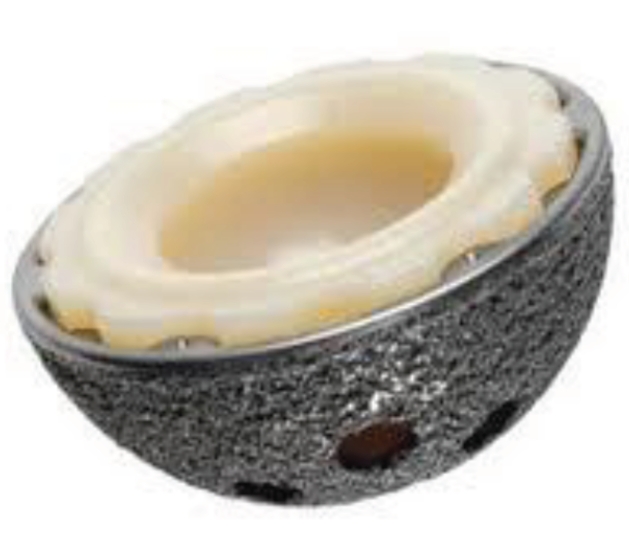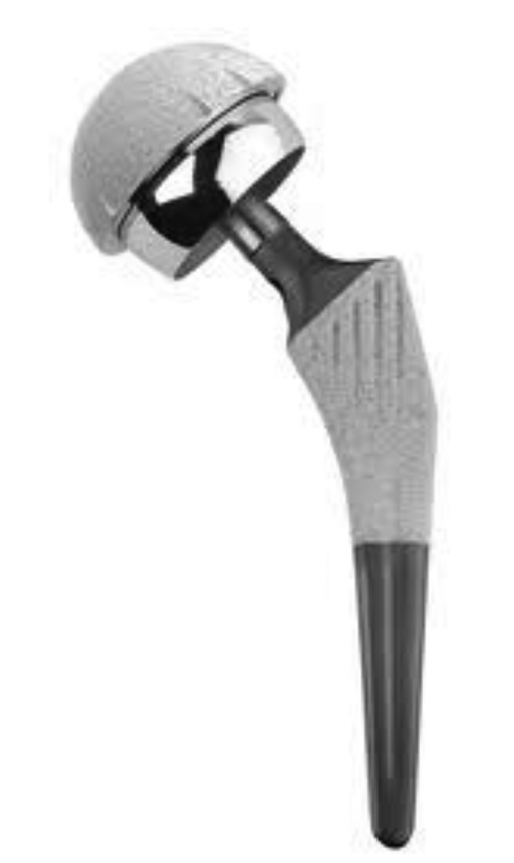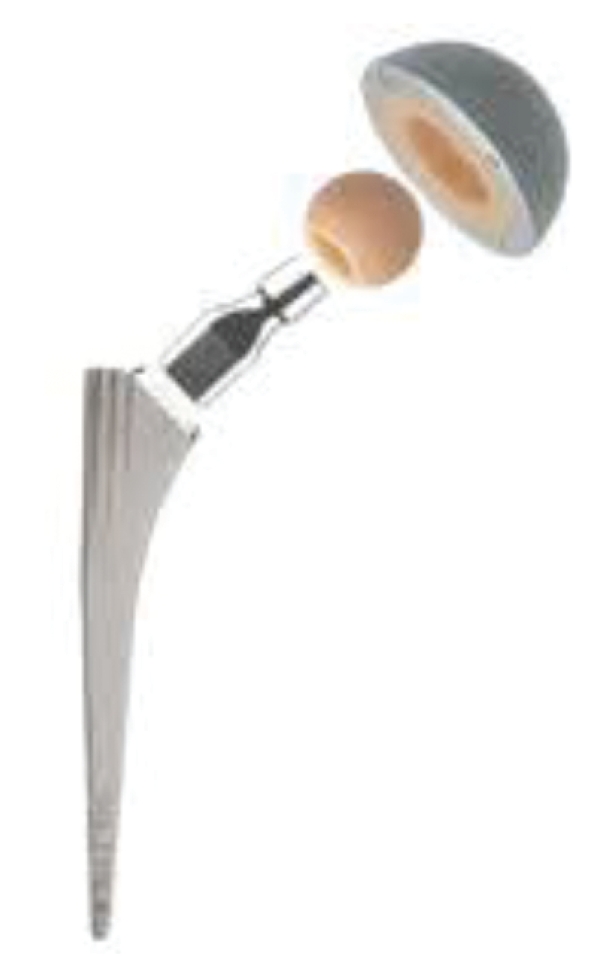Abstract
Total hip arthroplasty (THA) has completely revolutionized the nature in which the arthritic hip is treated, and is considered to be one of the most successful orthopaedic interventions of its generation. With over 100 years of operative history, this review examines the progression of the operation from its origins, together with highlighting the materials and techniques that have contributed to its development. Knowledge of its history contributes to a greater understanding of THA, such as the reasons behind selection of prosthetic materials in certain patient groups, while demonstrating the importance of critically analyzing research to continually determine best operative practice. Finally, we describe current areas of research being undertaken to further advance techniques and improve outcomes.
Key words: total hip arthroplasty, polyethylene, Metal-on-metal, ceramic, minimally-invasive.
Past
Total hip arthroplasty (THA) is considered to be one of the most successful orthopaedic interventions of its generation.1 The earliest recorded attempts at hip replacement occurred in Germany in 1891, with results presented at the 10th International Medical Conference. Professor Themistocles Glück presented the use of ivory to replace femoral heads of patients whose hip joints had been destroyed by tuberculosis. Later, surgeons experimented with interpositional arthroplasty in the late 19th and early 20th century, which involved placing various tissues (fascia lata, skin, pig bladders submucosa) between articulating hip surfaces of the arthritic hip.2
In 1925, the American surgeon Marius Smith-Petersen created the first mold arthroplasty out of glass. This consisted of a hollow hemisphere which could fit over the femoral head and provide a new smooth surface for movement. Despite glass being a biocompatible material, it failed to withstand the great forces going through the hip joint and shattered. Marius Smith-Petersen, along with Philip Wiles, later went on to trial the current material of choice - stainless steel - to create the first total hip replacement that was fitted to bone with bolts and screws.3,4
The first to use a metal-on-metal prosthesis on a regular basis was English surgeon George McKee. In 1953, he began by using the modified Thompson stem (a cemented hemiarthroplasty used for neck of femur fracture treatment) with a new one-piece cobalt-chrome socket as the new acetabulum. This prosthesis had a good survival rate, with one study recently showing a 28 year survival rate of 74%.5 Yet this method grew unpopular by the mid-1970's due to local effects of metal particles seen during revision surgery for prosthetic failure.6
The orthopaedic surgeon Sir John Charnley, who worked at the Manchester Royal Infirmary, is considered the father of the modern THA. His low friction arthroplasty designed in the early 1960's is identical, in principle, to the prostheses used today. It consisted of three parts; a metal femoral stem, a polyethylene acetabular component and acrylic bone cement - which was borrowed from dentists.7 It was called the low friction arthroplasty as Charnley advocated the use of a small femoral head which reduces wear due to its smaller surface area.
Present
Currently, in the 5th decade of modern THA, over 75,000 joint replacements are performed each year within the NHS.8 As the number of successful operations has increased, techniques have become standardised and the average age of those receiving hip replacements has reduced. As a result, this magnified the problems of implant failure due to wear of bearings. Thus there are a variety of bearing (Table 1) and techniques currently used in an attempt to find the combination that yields the fewest complications and best long-term survival.
Table 1. Comparison of materials used in total hip arthroplasty.
| Prosthesis | Advantages | Disadvantages |
|---|---|---|
| Metal-on-polyethylene | Large volume of evidence to support use Predictable lifespan Cost effective | Polyethylene debris leading to aseptic loosening |
| Metal-on-metal | Potentially longer lifespan than polyethylene due to reduced wear Larger femoral head - therefore lower dislocation rate | Metallosis Potential carcinogenic effect of metal ions |
| Ceramic-on-ceramic | Low friction Low debris particles Inert substance | Expensive Require expert insertion to prevent early damage Can produce noise on movement |
Metal-on-polyethylene
Metal-on-polyethylene (M-on-PE) (Figure 1) bearings are the most widely used and rigorously followed up of all the prostheses, making up the majority of THA undertaken in the UK today.9 Popularised by the early success of the Charnley prosthesis in the 1970’s, polyethylene-based implants almost completely displaced all other bearing surfaces. So much so that a large proportion of research was aimed at developing design and improving implantation techniques purely for the M-on-PE prosthesis.10 Currently the M-on-PE bearing provides a safe, predictable and cost-effective bearing for the majority of patients, and for many represent the gold standard in THA.9
Figure 1.

A polyethylene liner within a cementless titanium acetabular cup. Regenerex®.
The main concern for M-on-PE prosthesis is PE debris which creates periprosthetic osteolysis by the release of cytokines and proteolytic enzymes - ultimately leading to implant failure.11 PE wear debris is cited as the ultimate cause of most total joint arthroplasty failures today,12 leading to an increased frequency of hip revision due to aseptic loosening. Although debris may be minimised through the irradiation of PE with gamma particles, greatly improving the materials wear resistance, implant failure has led to renewed interest in metal-on-metal bearings.
Metal-on-metal
Metal-on-metal (M-on-M) (Figure 2) prostheses are experiencing a revival after falling out of favour in the 1970's. Previously, concerns were raised of the bearings potential to generate metal ions (metallosis), which had a theoretical carcinogenic risk, as well as associated hypersensitivity reactions and prosthetic loosening. It is now thought that the cause for aseptic loosening in first generation models was due to poor design and improper implantation technique rather than the M-on-M bearings themselves.
Figure 2.

A metal-on-metal femoral stem and cup. Note the hydroxyapatite coating over the proximal half of the femoral stem, constituting an uncentered femoral stem. Optimom®.
Prosthetic wear in M-on-M has been reported to be 60 times less than expected with conventional M-on-PE prostheses.13 In addition, as the metal femoral heads are less brittle than other materials they can have a larger diameter, increasing joint stability, and therefore the incidence of dislocation in these arthroplasties is lower.14 M-on-M implants also reduce osteolysis and peri-prosthetic inflammatory tissue compared to its polyethylene counterpart.15
An unknown entity in M-on-M bearings is the long-term effects of metal ions liberated, with cobalt and chromium ion blood levels tending to be 3–5 times higher than those patients with M-on-PE prostheses,13 Furthermore, many patients who receive M-on-M implants are younger (due to its wear characteristics), therefore potentially increasing the total length of the exposure to these metal ions over their lifetime. But such a carcinogenic risk from these metal ions remains theoretical, with only a few case reports of malignancies (mainly sarcomas) in publication to date.16
There is currently insufficient clinical follow- up to draw firm conclusions about the current new generation of M-on-M implants. Studies into the long-term outcomes are currently being conducted and results eagerly awaited.
Ceramic-on-Ceramic
First introduced by the French surgeon Pierre Boutin in 1970, half of the hip arthroplasties in central Europe use ceramic heads (Figure 3), but there is a much lower usage in the UK and USA (<10%).9,15 Developed to address the problems of friction and wear reported in other materials, the ceramic used in orthopaedics consist of either alumina or zirconia.
Figure 3.

A ceramic-on-ceramic prosthesis. Note the small head diameter. Stryker®.
The benefits of ceramic-on-ceramic (C-on-C) bearings are its high level of hardness, scratch resistance and the inert nature of debris compared to metal or PE versions.17 Furthermore these hydrophilic prostheses create improved lubrication, therefore resulting in a lower coefficient of friction and excellent wear resistance.18 Hence C-on-C bearings are a good choice of implant in young, active patients due to reduced wearing. However, the cost of ceramic implants is significant and for this reason these bearings are used infrequently in NHS orthopaedic units.
The risk of fracture in first generation alumina ceramic bearings was highly published. Chipping of the contact surfaces caused on insertion of the prosthesis, or as a result of dislocation due to the small femoral heads used in the ceramic implants, can lead to devastating third body wear so excellent surgical insertion technique is vital.9
Hybrid prosthesis
A hybrid hip prosthesis is formed from a cemented femoral stem and acetabular cup fixed in place with cementless techniques. This is an option for young, active patients as it prevents pelvic bone loss, to aid revision, yet still providing solid fixation and good usage. A major study in Norway showed that the use of hybrid systems offer better survivorship than a cemented socket in younger patients.19 It is though a technique seldom used in the UK given the poor clinical data for long-term follow-up.
Cementless techniques
Cementing hip arthroplasties was first described by Glück in 1891, using methacrylate bone cement to improve prosthetic fixation, but it was Charnley in the late 1950's that popularised this technique with a cement taken from dentists.7 Between these dates cementing often failed and attention was placed in the development of cementless techniques. The role of cement is to act as a grout rather than a glue to improve the fit of the prosthesis – and theoretically its survival. Cementless prosthesis have a specialized coating, hydroxyapatite, that allows ingrowth of bone and thus fixation of the prosthesis.
Cementless techniques allow for easier planning of hip revision surgery, particularly in the younger patients, with greater preservation of bone tissue. However, better short to medium-term clinical outcomes were found for cemented over uncementless techniques, with no radiological differences seen.20 Long-term comparison is difficult to make due to lack of large randomized controlled trials.
Future
Minimally invasive surgery
Gaining popularity in recent years, minimally invasive techniques are currently being developed. The use of a single-incision, less than 10 cm in length using conventional surgical approaches, provides soft-tissue sparing and bone conservation options. Studies have demonstrated that it provides the possibility of reduced intra-operative blood loss, shorter hospital stay, faster rehabilitation and an improved cosmetic result while not compromising complication rates or physical function post-op.21,22 Meanwhile opponents cite the risks of such an approach, including limited visibility of anatomical landmarks and vital structures.23 There also remains a question as to whether using such a technique increases the chance of component malposition.
Computer-assisted surgery
Entering its second decade of use, computer-assisted total hip replacement utilizes digital image systems to map the position of surgical instruments in relation to anatomical landmarks, helping to obtain reproducible and accurate placement of implants. Computer navigation may improve the accuracy of prosthesis positioning but, despite its obvious advantage with respects to reducing asymmetric wear, this has not yet been shown to have a clinical benefit.21
In actuality navigation leads to increased surgical time, elevated costs and operative complexity.21 On the other hand it is a useful tool in order to conduct research into prosthesis positioning and clinical outcome. Some discussion as to whether the combination of computer-assisted surgery with a minimally invasive approach can help to improve outcomes is ongoing – but at present greater quality designed studies and the mastering of this surgical technique is required before such techniques can be formally analysed.24
Conclusions
Since the first total hip arthroplasty in 1891, research has developed from perfecting surgical technique to advances in technology (with respects to both prosthesis design and materials) in order to provide a reproducible technique that provides a good range of motion, stability and most importantly adequate life span. As the average age of those receiving hip arthroplasty decreases, such considerations will continue to be of great value to increase implant longevity in highly active patients. Despite over a 100 year history of total hip arthroplasty, a technique and material to suit all patient characteristics is not yet a reality.
References
- 1.Callaghan JJ, Albright JC, Goetz DD, et al. Charnley total hip arthroplasty with cement. Minimum twenty-five-year follow-up. J Bone Joint Surg Am. 2000;82:487–97. doi: 10.2106/00004623-200004000-00004. [DOI] [PubMed] [Google Scholar]
- 2.Learmonth ID, Young C, Rorabeck C. The operation of the century: total hip replacement. Lancet. 2007;370:1508–19. doi: 10.1016/S0140-6736(07)60457-7. [DOI] [PubMed] [Google Scholar]
- 3.Smith-Petersen MN. The classic: evolution of mould arthroplasty of the hip joint. J Bone Joint Surg. 1948;30B:L59–L59. [PubMed] [Google Scholar]
- 4.Wiles P. The surgery of the osteo-arthritis hip. Br J Surg. 1957;45:488–97. doi: 10.1002/bjs.18004519315. [DOI] [PubMed] [Google Scholar]
- 5.Brown SR, Davies WA, DeHeer DH, Swanson AB. Long-term survival of Mckee-Farrar total hip prosthesis. Clin Orthop Relat Res. 2002;402:157–63. doi: 10.1097/00003086-200209000-00013. [DOI] [PubMed] [Google Scholar]
- 6.McKellop H, Park SH, Chiesa R, et al. In vivo wear of three types of metal on metal hip prostheses during two decades of use. Clin Orthop Relat Res. 1996;329:S128–40. doi: 10.1097/00003086-199608001-00013. [DOI] [PubMed] [Google Scholar]
- 7.Charnley J. Arthroplasty of the hip: a new operation. Lancet. 1961;1:1129–32. doi: 10.1016/s0140-6736(61)92063-3. [DOI] [PubMed] [Google Scholar]
- 8.The NHS Information Centre. Hospital Episode Statistics for England. Inpatient statistics, 2009–10. Available from: www.hesonline.nhs.uk.
- 9.Sandhu HS, Middleton RG. Controversial topics in orthopaedics: ceramic-on-ceramic. Ann R Coll Surg Engl. 2005;87:415–6. [PMC free article] [PubMed] [Google Scholar]
- 10.Amstutz HC, Grigoris P. Metal on metal bearings in hip arthroplasty. Clin Orthop Relat Res. 1996;329:S11–34. doi: 10.1097/00003086-199608001-00003. [DOI] [PubMed] [Google Scholar]
- 11.Bizot P, Nizard R, Hamadouche M, et al. Prevention of wear and osteolysis: alumina-on-alumina bearing. Clin Orthop Relat Res. 2001;393:85–93. doi: 10.1097/00003086-200112000-00010. [DOI] [PubMed] [Google Scholar]
- 12.Amstutz HC. Editorial Comment. Clin Orthop Relat Res. Metal on Metal Hip Protheses: Past Performance and Future Directions. 1996;329:S2–S3. [Google Scholar]
- 13.Cuckler JM. The rationale for metal-on-metal total hip arthroplasty. Clin Orthop Relat Res. 2005;441:132–6. doi: 10.1097/01.blo.0000193809.85587.f8. [DOI] [PubMed] [Google Scholar]
- 14.Archibeck MJ, Jacobs JJ, Roebuck KA, Glant TT. The basic science of periprosthetic osteolysis. Instr Course Lect. 2001;50:185–95. [PubMed] [Google Scholar]
- 15.Boutin P. Total arthroplasty of the hip by fritted aluminum prosthesis. Experimental study and 1st clinical applications. Rev Chir Orthop Reparatrice Appar Mot. 1972;58:229–46. [PubMed] [Google Scholar]
- 16.Tharani R, Dorey FJ, Schmalzried TP. The risk of cancer following total hip or knee arthroplasty. J Bone Joint Surg Am. 2001;83:774–80. doi: 10.2106/00004623-200105000-00019. [DOI] [PubMed] [Google Scholar]
- 17.Bierbaum BE, Nairus J, Kuesis D, et al. Ceramic-on-ceramic bearings in total hip arthroplasty. Clin Orthop Relat Res. 2002;405:158–63. doi: 10.1097/00003086-200212000-00019. [DOI] [PubMed] [Google Scholar]
- 18.Christel PS. Biocompatibility of surgical-grade dense polycrystalline alumina. Clin Orthop Relat Res. 1992;282:10–8. [PubMed] [Google Scholar]
- 19.Havelin LI, Engesaeter LB, Espehaug B, et al. The Norwegian Arthroplasty Register: 11 years and 73,000 arthroplasties. Acta Orthop Scand. 2000;71:337–53. doi: 10.1080/000164700317393321. [DOI] [PubMed] [Google Scholar]
- 20.Ni GX, Lu WW, Chiu KY, Fong DYT. Review article: Cemented or uncemented femoral component in primary total hip replacement? A review from a clinical and radiological perspective. J Orthop Surg. 2005;13:96–105. doi: 10.1177/230949900501300119. [DOI] [PubMed] [Google Scholar]
- 21.Reininga IH, Zijlstra W, Wagenmakers R, et al. Minimally invasive and computer-navigated total hip arthroplasty: a qualitative and systematic review of the literature. BMC Musculoskeletal Disorders. 2010;11:92–92. doi: 10.1186/1471-2474-11-92. [DOI] [PMC free article] [PubMed] [Google Scholar]
- 22.Berry DJ, Berger RA, Callaghan JJ, et al. Minimally invasive total hip arthroplasty: development, early results, and a critical analysis - presented at the Annual Meeting of the American Orthopaedic Association, Charleston, South Carolina, USA, June 14, 2003. J Bone Joint Surg Am. 2003;85A:2235–46. [PubMed] [Google Scholar]
- 23.Callaghan J. Skeptical perspectives on minimally invasive total hip arthroplasty. J Bone Joint Surg Am. 2006;85:2242–3. [Google Scholar]
- 24.Archibeck MJ, White RE., Jr Learning curve for the two-incision total hip replacement. Clin Orthop Relat Res. 2004;429:232–8. doi: 10.1097/01.blo.0000150272.75831.2f. [DOI] [PubMed] [Google Scholar]


